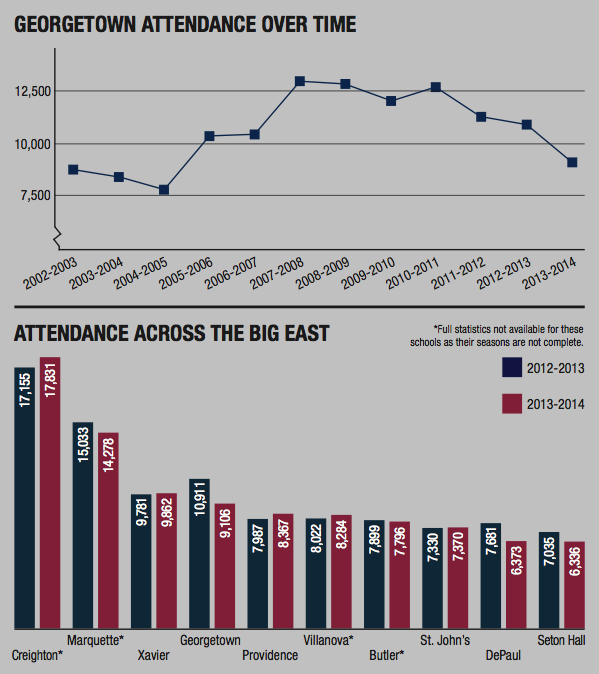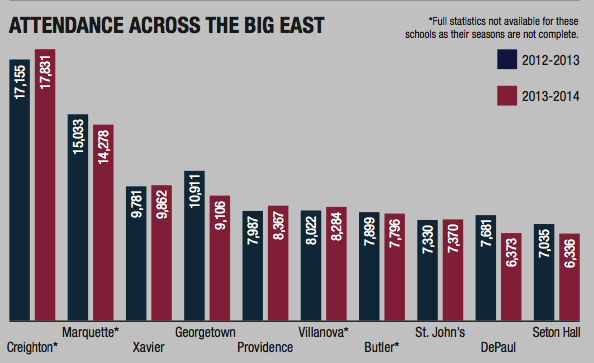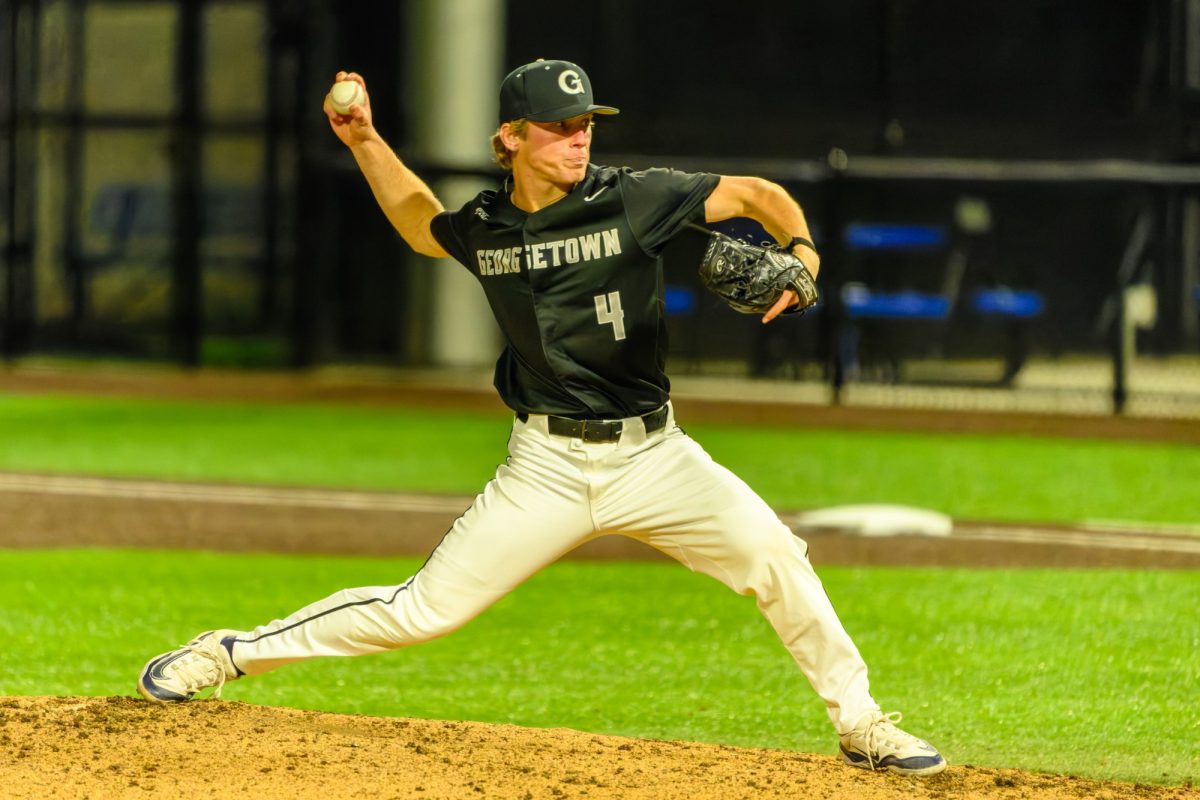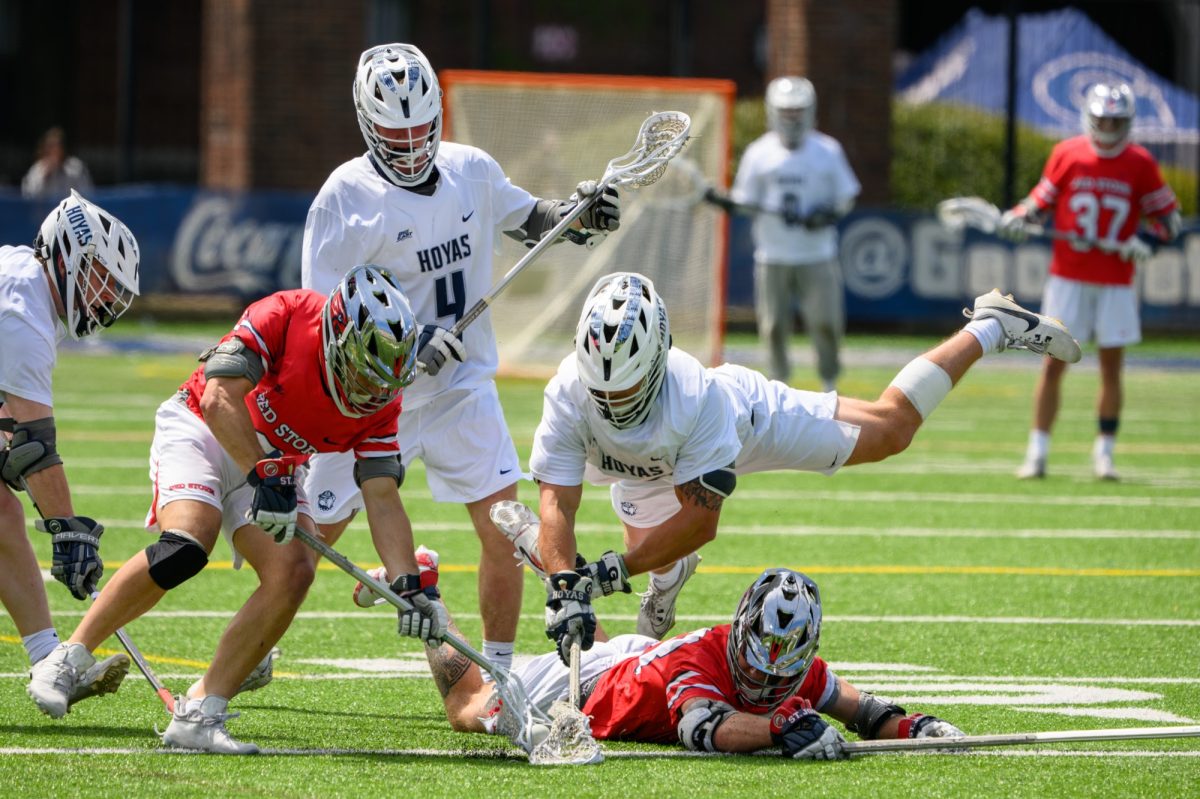
The decrease — from an average of 10,911 fans last year to 9,106 this year — comes as the Hoyas played their first season in a Big East that was wracked by realignment and lost several of its marquee programs to the Atlantic Coast and American Athletic Conferences.
However, factors besides realignment likely played into this attendance drop. This year’s team sits at 17-12 headed into Saturday’s season finale at Villanova, while Otto Porter, who left Georgetown for the Washington Wizards at the end of last year, led the Blue and Gray to a 24-5 record in 2012-2013.
In a statement, Senior Associate Athletics Director for External Affairs Dan O’Neil also cited “unique start times and several big conference games being played on weekdays rather than weekends” as factors at work in this year’s attendance figures in a statement sent by email to The Hoya.
Nation’s Best to Verizon
Formed in 1979, the Big East enjoyed a golden age in basketball after 2005, when Cincinnati, DePaul, Louisville, Marquette and South Florida joined the league.
In the eight years that followed that annexation, the Big East sent a total of eight teams to the NCAA Final Four, including two teams in both 2009 and 2013.
In 2012, West Virginia began a wave of departures that culminated with seven schools — Cincinnati, Connecticut, Louisville, Notre Dame, Pittsburgh, Syracuse and South Florida — leaving for other conferences in 2013.
Those eight teams won 11 of the 12 Big East tournaments before the conference broke up and represented much of the upper echelon of college basketball.
The Hoyas saw their attendance spike during that era, climbing from an average per game of 8,796 in 2002-2003 to a high-water mark of 12,826 in 2008-2009 — even though the Hoyas lost in the first round of the National Invitation Tournament that year.
Realignment Alters Schedule
Although the Catholic Seven that form the nucleus of the new league enlisted well-regarded basketball schools Butler, Creighton and Xavier, the current Big East is widely perceived to be less competitive than it once was.
To a certain extent, this is reflected in year-over-year attendance figures. Aside from the rivalry game with Syracuse, eventual national champion Louisville was the biggest draw last season, pulling in 17,474 fans. This year, a date with unranked Butler was the best-attended game, with an announced crowd of 13,011.
However, not all of the Big East schools have seen their attendance decline this season. While DePaul’s average has fallen by 17 percent — the most of any team — and Seton Hall’s crowds have dipped by 9.9 percent, Villanova and Providence have seen increases of 3.3 and 4.9 percent, respectively. Figures for other teams are not final, as some teams have one home game remaining in the 2013-14 season.
Overall, the 10 Big East members have seen an 8.5 percent drop in average home attendance compared to a season ago. So why was Georgetown’s decline steeper?
Orange Rivalry Drew Big Crowds
One possible reason is the defection of Syracuse from the league.
The Hoyas’ meeting with the Orange was one of the biggest dates on the college basketball calendar. Consistently Georgetown’s best-attended home game, last season’s meeting at Verizon Center drew the largest crowd ever for an indoor sporting event in the Washington metro area.
In an interview, Georgetown University Student Association Vice President and former Hoya Blue Communications Officer Adam Ramadan (SFS ’14) pointed to the need for new rivalries to help boost attendance.
“Is Creighton going to be a new rival? Is Butler going to be a new rival?” Ramadan said. “We need to let new rivalries develop in an organic way, the way the Syracuse rivalry did. That’s just not going to happen in one year.”
O’Neil echoed Ramadan’s argument and added that the 10-team league means that Georgetown faces each one of its conference rivals at home every season, making a rivalry more viable than it was in the 16-team Big East, where some teams met only once a year.
“We look forward to how the Big East Conference, with the scheduling of annual home-and-home series and the new rivalries that are being created, will help to increase our attendance numbers down the road,” O’Neil said in his statement.
Game Times Not Optimal
Several of Georgetown’s biggest home games this season were played on weeknights, something that O’Neil mentioned in his statement.
For instance, the Hoyas faced then-No. 9 Villanova at 9 p.m. on a Monday night and No. 13 Creighton at 7 p.m. on a Tuesday night this year. Last season, home matchups with both Louisville and Syracuse were held on Saturday afternoons.
Head Coach John Thompson III has already urged Big East Commissioner Val Ackerman to consider changing the league basketball schedule to avoid periods of only one day between games.
However, television — more than attendance — often dictates the scheduling of games, complicating Georgetown’s hopes of avoiding similar timing complications in future years
Nonconference Schedule
A common complaint among fans is that Georgetown hosted a weak slate of nonconference opponents this season.
Last season, a date with Tennessee in the Big East-SEC Challenge drew 13,656 fans. This season, the highest crowd before league play was the 8,165 on hand to see Georgetown play Lipscomb.
In part because of the changing dynamics of college basketball, many of the top nonconference games are now held on neutral sites.
Georgetown played four ranked teams outside the Big East this year but faced three of them at neutral sites: then-No. 19 Oregon in South Korea, then-No. 10 Virginia Commonwealth at the Puerto Rico Tip-Off and then-No. 7 Michigan State at Madison Square Garden.
The fourth nonconference game against a ranked opponent was a visit to Lawrence, Kan., to take on Kansas at Allen Fieldhouse. The Jayhawks will come to Washington next December for the continuation of the series, giving the 2014-2015 schedule a standout nonconference game.
Although there is fan agitation to get more teams to the Phone Booth, there are clear reasons for Thompson and his staff to pursue a more cautious mix of opponents.
“From a fan’s perspective, I would like to see more top teams come to Verizon Center,” Ramadan said. “From a coaching perspective, I’m sure they see a reason to play Duke for a few years and then wait before setting up the Kansas series.”
The biggest remaining issue for the nonconference schedule — the renewal of the Georgetown-Syracuse series — has been widely discussed but concrete arrangements have not yet been made.
Cautious Optimism
In response to lagging student attendance — and the sight of partially empty student sections —GUSA, student pep club Hoya Blue and the athletic department initiated a limited direct busingprogram this season.
Under the arrangement, students were able to take shuttles to Verizon Center for all Georgetown games if they attended two out of the first three games or half of all non-conference games.
While separate figures for student attendance are unavailable, Ramadan said he was pleased with the results of direct busing, while acknowledging student attendance could still improve.
In his statement, O’Neil indicated that direct busing — and other promotions begun this year — would continue.
“We were very happy with our first season of renewing direct busing to Verizon Center for select student season ticket holders, and we are excited to see that program grow,” O’Neil said. “We also had success with many new promotions targeting Georgetown alumni, parents and fans.”
If student attendance improved, Georgetown could revert to full student sections on both baselines. Large signs promoting the Hoyas on social media have replaced what used to be student seating.
Attendance Didn’t Slow Hoyas
Despite the declining crowds, Georgetown won 12 of its 15 home games this season, only a bit off its 16-1 mark at Verizon Center last season.
And one group claimed victory in attracting more fans. The Stonewalls — the section 118 group of Georgetown alumni that are known for the ubiquitous tifos signs — saw the attendance in their section grow this year.
“We hope even more fans will join us next season, particularly all the new young alumni who will be graduating this year,” board member Nick Sementelli (SFS ’09) said.















